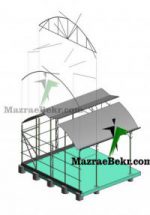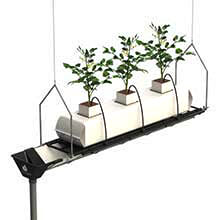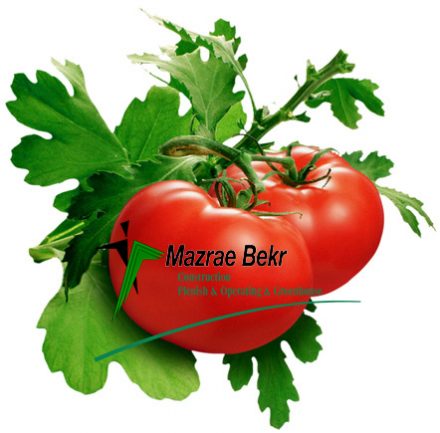Greenhouse Tomato Cultivation in Iran
Greenhouse of tomato and their conversion products are one of the most important products of conversion industries in the world. The production of this product in the greenhouse has the conditions described in this article, from the results obtained in recent years, lycopene, which is abundantly present in tomatoes and its products, has properties such as Prevention of prostate cancer, increased breast milk, skin protection against UV radiation, prevention and consequently prevention of stroscellerosis and many LDL cholesterol-related diseases Gastrointestinal tract.
Vegetation Characteristics of Greenhouse Tomatoes
Tomato belongs to eggplant or potato family and is made oftomato (Lycopersicum esculentum) and domestic tomato species (Lycopersicum sp.) Tomato is a greenhouse intrinsicly a herbaceous and perennial plant that is often planted annually in all parts of the world.
Greenhouse tomato root
The roots of the young plant are greenhouse tomatoes vertically, but with the growth of the plant, the main root is relatively narrow and finally hardly recognizable from the inorganic roots. In the main root collar, the forging roots are separated. In young plants, greenhouse tomatoes are between 4-25 mm in diameter. Lateral roots, unlike the main roots that grow downwards, have horizontal growth, so the root depth is different in different growth periods of tomato plants. Greenhouse tomatoes have a wide root system and can penetrate even up to 150 cm depth, but generally 72% of the roots are at a depth of 0-20 cm and 22% at a depth of 0-50 cm and 6% remaining below 50 cm above groundlevel.
Leg
The stem of tomato plant is greenhouse, herbaceous, round, smooth and crumbling and with age it becomes cornered, hard and almostdry.
Leaves
The leaves of greenhouse tomato plants are composed of alternating and composed of cut and wrinkled leaves. The size of the leaves varies depending on the variety of tomatoes. The number of leaves and leaves will vary in terms of variety, temperature and lightconditions.

Flowers
The flowers are clustered and appear on the stem between two successive nodes. The flowers are full and have male organs (flags) and female organs (mud). The flowers are intermittently placed on the flower cluster and have a yellow color. There are several flowers (usually 4 to 8 flowers) in each inflorescerating flower (cluster). Flowers have 5 or 6 petals with a length of 1 cm which are attached at the base and separated at the end. The bowls are 5, drawn and sharpened. 5 flags with large frequencies and short bars form the flowerorgans.
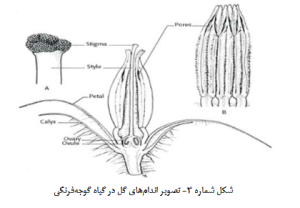
Fruit
Tomato fruit is a greenhouse in terms of botanically a meaty and juicy set that includes eggs or seeds surrounded by a pile of gelatinous and meat sheaths and covered on it with thinskin.

Greenhouse suitable for greenhouse tomato cultivation
In the construction of a greenhouse greenhouse and setting up a successful greenhouse, it is necessary to pay attentionto the type and specifications of the greenhouse structure and its coating and equipment.
In, Iranian and Spanish greenhouses with a minimum height of 5 meters and resistant to wind and snow in the region and crop weight, are suitable.
It should be noted that the cultivation of greenhouse tomatoes in greenhouses with a height of less than 5 meters can also be done, but the greenhouse companies that offer or produce these greenhouses are not carefully comparable to the amount of production per unit area and the minimum cost with maximum profit, because when with 30 percent more initial and fixed cost, it can reach 80 percent more profit, so It is rational to choose according to the greenhouse conditions that meet the minimum standards.
And in the cultivation of greenhouse tomato hydroponics, greenhouses with a minimum height of 6 meters are recommended.
mazrae bekr Company, structure of Spanish greenhouses and Iranian greenhouses according to topography, climate and climatic conditions prevailing, soil type of each region, etc. as well as these greenhouses in accordistan with standards 76UNE-92/208, 284CEN/TC and 57NFU-063 and Regulations of Iran and NGMA of America and ECMC (European Union of Steel Structures) with the best and most resistant materials designed and offers the most economical structure that these greenhouse greenhouses, in different designs up to 110 kg/m2 snow load and 120 km/s wind speed (subject to the closure of valves) and 20 kg/m2 of product load are resistant.

Selecting the suitable cultiro cultiro cultiros for killing in greenhouse
Selection of culties for greenhouse tomatoes in a region is very important. This cultivar should be resistant to pests, diseases and unfavorable conditions of the region (low light, low temperature, etc.) and can produce a high quality and quantity product in theseconditions.
Classification of greenhouse tomatoes based on growth habit (stemshape)
Determinate’s end-to-end or limited growth
These figures are used for outdoor plants and are used to produce industrial tomatoes. In these cultivars, there is usually an inflorescerating flower for every two leaves. At the end of each sub-branch, after producing 2 to 3 leaves, an inflorescess is created and then stops. On the cluster, fruit and then the sub-branch is created and the bush around the main stem is in a couplingstate.
Semi-Determinate
In these cultivars, there is one inflorescess for all three leaves and finally one flower is produced in the end bud. These products have the maximum production in a shorter distance and are very effective for short-term greenhouse ships inautumn.
Non-end or unlimited growth(Indeterminate)
These figures are used in greenhouses and open spaces which are climbing and are mostly for fresh consumption. In these cultivars, there is usually an inflorescessum for all three leaves and the end bud continues to grow. Inflorescents are created in the corners of the main and secondary stems and the growth of the plant does notstop.
Category based on average fruit weight
Nowadays, according to the consumer’s tastes for fresh consumption of tomatoes, cherry tomatoes weighing approximately 5 to 20 grams to tomatoes weighing 250 grams are used. It should be noted that the weight of tomatoes is heavy, the longer it takes to achieve the yield. For example, cherry tomato after transplantation for production of about 55 to 60 days and coarse tomato 250 g requires at least 90days.
Categorization by fruit time
در مجموع گوجه فرنگى بر اساس رسيدگى نسبى به ارقام خيلى متوسط ،(Early Maturity) زودرس ،(Very Early Maturity) زودرس ،(Medium Maturity) متوسط رس ،(Medium Eearly Maturity) زودرس خيلى ،(Late Maturity) ديررس ،(Medium Late Maturity) متوسط ديررس تقسيم بندى مى شوند. (Very Late Maturity) ديررس
Categorization based on the shape, color and taste of the fruit
Wide, (Globe) a fruit of greenhouse tomatoes in square round or round cornered shapes,(Deep Oblate) is completely wide,oblate or plate,square elongate or oval, elliptical or eggSquare Round is marketedin green, yellow, orange, red, and plum, and date or cherry, purple cherry and sweet to sour flavors. .
Categorization based on the uniformity of the product
Tomato bushes are divided into three categories: co-ordinate, non-concurrent and interstitine. Usually, in Greenhouses of Iran, non-concurrent varites are used in long-term and medium-term harvests in areas with shorter harvestdurations.
Categorization based on harvest method
It is harvested that cluster and cluster (single) tomatoes are divided into two forms of single type in two forms of harvesting with and without paperberg, recently new varieties called clusters have entered the market in which fruit picking and harvesting is done in clusters.
Categorization based on consumption method
(Processing) And industrial (Fresh) tomato product in fresh form (paste, sauce, canned, etc.) It is consumed. Currently, in Iran for growing tomatoes in greenhouses, only fresh edible cultivars are used, of course, in cases where due to various reasons such as adverse environmental conditions or harvesting in the final chinas, fruit in terms of shape and size has the necessary quality and marketability there is no choice but to consume it industrially.
Classification based on the degree of resistance to pests and diseases
With advances in seed production, varieties have been introduced to the market that have a variety of low resistance against nematodes, fungal diseases, bacteria, viruses and some pests. (High Resistance) High resistance
Fruit transport and storage capability
Long Shelf Life (LSL) features are high transportation and storage capabilities. (Firmness) The importance of tomato fruit is that it indicates the firmness of the fruit of seed planting operations in the greenhouse.
In general, to choose one of the varieties, the purpose of growing tomatoes should be the size and color of fruit, prematureness or lateness, resistance to pests and diseases, etc. and chose a suitable figure. For example, if the goal of picking tomatoes is clustered, cluster varieties are used. Some greenhouse tomato varietiesinclude:
Cherry greenhouse tomatoes: which have fine fruits.
Greenhouse anemones tomatoes: premature, unearthly, strong bushes, round fruits, stiff, abundantfruiting.
Vendor: Has medium fruits with thick skin and high quality, resistant to viral diseases and leaf spots but is allergic to root rot and gray mold.
Barbara: It has high yield and excellent taste and is also resistant to bacterial spot diseases, fusarium and verticelium.
Simesk: Has very strong bushes, high adaptability, 5 to 6 fruits per cluster, average fruit weight of 210 to 250 grams and resistant to fusarium and verticelium.
Nowadays, there is a great tendency to cultivate cherry or cherry cultivars because it has good fruiting and various colors and different shapes and goodmarketability.
Date and time determination of greenhouse tomato culture
The history of greenhouse crop culture according to the type and nature of the figure, the existing environmental conditions, economic factors, etc. It should be determined that the best increase in the quality and quantity of the product is achieved. In greenhouse plants, unfavorable times should be removed from the cropping period and should not be placed in the harvest distance. Therefore, it is better to carry out the ship in such a way that the unfavorable seasons are at the beginning of the season or the end of the harvest season. In addition, the date of planting of the product should be such that at the time of harvest, the product has a reasonable price to offer to themarket.
Spring ship
This ship usually starts from the beginning of November to early December. Transplants are transferred to the main greenhouse land in mid-January and the crop can be harvested from late March to late June. Sometimes they change the date of spring planting and plant tomato seeds from the last decade of December to the last decade of January and transfer the transplants from the second decade of February to the first decade of March to the main land of the greenhouse and in this case the crop can be harvested from mid-April to the end of the month. In spring ship, if environmental conditions are favorable, harvesting will continue until autumn (mid-November). This ship is more important because of the long growing season (about 5 months or more) and theloading.
Autumn ship.
Autumn shiping of greenhouse tomatoes usually starts in late June and early June. Transplants are transferred to the main greenhouse land from early to late August and the crop can be harvested from mid-October to mid-December.
In greenhouse tomatoes, areas with cool summer and mild winter will be possible two ships per year. But in areas with hot summer and spring harvest, it is possible until the end of May, and of course it is better to use an interstitian ship instead of two ships peryear.
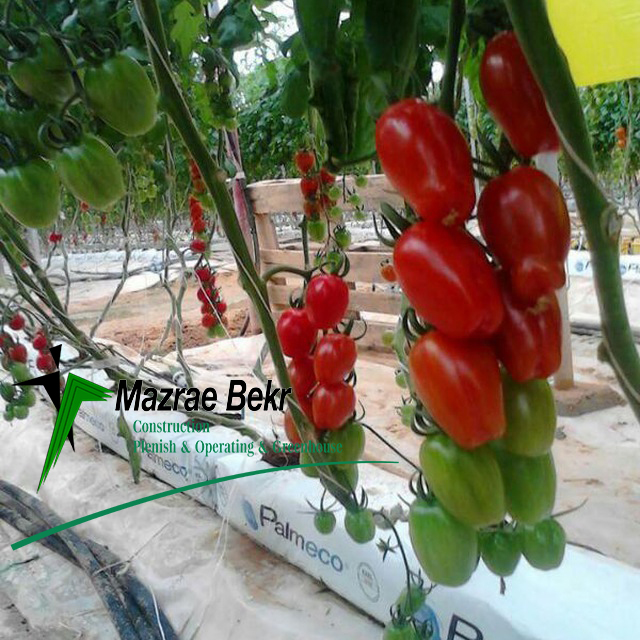
Preparation of greenhouse tomato planting bed
Greenhouse tomato plant needs sandy or sandy lumy, canopy, soft, deep with suitable drainage for spreading its deep and strong roots.
Considering that the most activity of roots is at a depth of 30 cm, before transferring tomato seedlings to the main land, suitable substrates that have the ability to penetrate the roots up to soil for pH of 80 cm depth. With cocopeat and perlite and cocochips and…
Greenhouse tomato planting
The seed planting of greenhouse tomatoes is done in two forms: direct (seed) and indirect (transplantation) which in greenhouse conditions only indirect culture method isrecommended.
Indirect ship
Indirect planting leads to faster supply of products to the market, reduction of losses in hybrid seeds and production of strong and healthy transplantation. In this method, for every 500 square meters of the main land, 2 to 3 square meters of space is needed to create the treasury. Indirect cultivation in the treasury is generally carried out in pots and transplanted trays in twoforms.
Seed cultivation of greenhouse tomatoes in transplant pots: Before planting, we plant the left seeds for 1-3 days until softened and ready for the young hazing. Put 7 cm and transfer to /5 – then release to a depth of one centimeter of final golda to a diameter of 10 treasuries and transfer the appropriate conditions in terms of light, temperature, humidity, etc. we provide.
Seed culture in transplanted tray: 55 cm) from a suitable soil mixture (peat mouse, etc.) filled × sini nha (27 1 cm) and 500 to 600 seeds To / and with a wooden board, sprinkle the soil surface up to a depth of 5 0/face or plant in regular rows and cover it with soft soil at a height of 5 cm and transfer it to the treasury. Cover the tray with cute plastic and after the appearance of buds, we remove the plastic layer to provide favorable conditions for plant growth. With the emergence of the first true leaf, it is time to treat the cold and then the seedlings should be transferred from the transplanted tray to the transplant pots without any damage and immediately immunizethem.
Environmental factors affecting seed germinating and tomato seedling production
4 days and the duration of growth after transplantation – The average germinating time of tomato seeding in soil is 6-60 days (this period depends on the type of cultigraphy).
Temperature
The best temperature for germiation of tomato seed in greenhouse is 25 to 30 °C. (The lower the temperature of the treasury environment should not be from 12 to 15 °C and the higher the 35°C) the lower the temperature, the longer the germination will be.
Light
From planting to seed germination, there is no need for light, but after germination and greening of transplants, more light (naturally or artificially) should be provided for the plant so that photosynthesis and food processing begins and no light competition is created between thebushes.
Abyari
The required watering for germinating and transplant growth should be done by daily visits and the pots of cultivation should not be dried. Before germination, mild watering is done in the form of fogging so that the seeds do not come out from under the soil due to water pressure. On hot and light days, irrigation summer is done several times a day, but on cold and low days of winter, irrigation is done 2-3 days. The moisture content required for the treasury environment is 60-80%.
Carbon d-oxide
1000 increases the growth of transplantation, because the ppm of using carbon d-oxide with the concentration of the treasury surface is small, hence the d-oxidizing of carbon oxide is economically justitability.

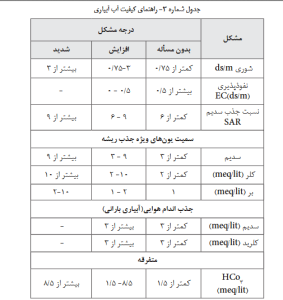
Transferring transplants to the main ground
The time of transplantation to the main land is when the height of the plant is 30 to 20 cm, in this case two real leaves other than 2 leaves of pea are created in the plant, which usually takes 12-15 days for 2 sheets and 20 days for 4 sheets. The best time of transplantation was 6-4 weeks after seed planting in the treasury. It is advised to irrigate the land 12 to 14 hours before transfer.
Pollination in tomatoes
A greenhouse tomato plant needs pollination to bear fruit. In open air cultivation, pollination is done by wind and shaking of bushes, but in greenhouses where space is closed and there is no wind, they shake the bushes by hand or hit the tubed paper on the cluster. However, since this is costly at large levels, the vibration of flowers can be performed by electrical device on theguardians.
Pollination time will be somewhat effective in the number and size of fruits. Daily pollination between 10 a.m. and 2 p.m. in mid-spring and summer and 11 a.m. to 3 p.m. in the winter to early spring months is very suitable.
Greenhouse tomato flowers, unlike cucumbers, need pollination to form fruit. Tomato flowers are perfect and often flowering themselves. When pollinating pollination, pollen grains are separated from an antecedum and some of them are placed on the stigma of the same flower and sometimes on the stigma of the other flower, causing inoculation of theeggs.
In autumn, which is low light intensity, flower inoculation and fruit formation decreases in terms of lifting the length of cream compared to the flag rod. Since flower inoculation is not completely performed, incomplete inoculation of flowers also leads to the formation of inadequate and non-uniform seeds inside the fruit and eventually produces low quality, deformed and troughfruits.
If the inoculation is not performed well, the flowers will fall. Therefore, other stimulants should be used to release flowerpollen.
- The use of pollinator bees, whose life is one season. This indirectly causes shock to the plant and inoculation, which is a good result because they pollinate all the flowers and reduce the labor costs and are active all day. For every 2,000 square meters, a hive of these bees is enough.
- Hitting flowers with piped paper and brush, which is usually not used in largegreenhouses.
- The use of electric vibrators or electric vibrators, known as electric bees, is used every two or three days or hitting the harness wires every other day.
Note:In cold seasons, foliar growth regulators are used to spray on flower clusters based on a regular program in order to prevent flower loss and increase fruiting.
tomato Pollination time
In order to do pollination in the greenhouse, it is better to have temperatures in the greenhouse between 20 and 25 °C and its humidity is also low, at temperatures above and below this level, the inoculation of flowers is not well done that the inoculation of the flower will cause the flower to fall, so the temperature of the greenhouse in the day and at the time of pollination should not be higher than 28 °C and at night from 15 degrees. lower centigrade.
Cloudy days and high humidity conditions cause pollen grains to stick together, causing incomplete inoculation or inoculation of flowers. Fruit formation and its coloring in tomato plant is a function of several important factors of food, temperature and duration oflight.
Sunlight does not directly affect the color and size of tomatoes under suitable climatic conditions. Usually, 18 to 35 days after inoculation of flowers, fruits can be harvested, ethylene hormone can be used when it is cold to color the fruits when the leaves close to each fruit cluster are removed, the fruit can be better colored according to the type of cultior and purpose of tomato cultivation.
For example, if half of the cluster of cluster varieties has been finalized, it can be arranged and marketed if the distance from the farm to the market is low and the semi-green cluster does not have the opportunity to colorize, it can be used a place whose temperature has a good heat to change the color of the tomato. If the varieties are not in the form of classier or concurrent, it is better to harvest ripe tomatoes at their owntime.
Of course, the larger the size of the tomato, the longer it will be to convert the flower to fruit and reach it. Today, many farmers tend to grow cherry tomatoes because of the suitable consumer demand, and this is due to the high fruiting rate, red, pink and yellow colors and its different shapes, which has caused the high price of thisvariety.

The role and symptoms of nutrient deficiency in tomato plants
– (N)
Deficiency of ut in plants reduces jibralin, oxin and increases growth inhibitors, D. D. O deficiency leads to stopping the growth of air organs and with yellowing of the color of old leaves. The loss of a large number of flowers at high temperatures due to lack of ut in tomato plant S.T. Size, color, taste and percentage of solids in the fruit decreases due to high consumption of D. In general, too much of you reduces plant resistance todiseases.
– (P)
The presence of sufficient phosphorus in the root environment leads to its rapid development and better use of water and other necessary foods of the plant. Phosphorus with ut and potassium improves skin color and flesh and fruit stiffness and acceleratesmaturity.
– (K)
The symptoms of potassium deficiency in tomatoes are in the form of inter-vein chlorosis in mature and middle leaves, appearance of necrosis points and the appearance of fueling state on the margins of leaves. One of the reasons for disruption in fruit ripening, poor potassium nutrition in tomatoes and S.T. Deformity and non-uniformity of fruit color decreases with increasing potassium consumption. Potassium consumption increases carotenoids, lycopene and decreases chlorophyll and has a great effect on the metabolism of fruit acids (mainly citrik acid and malic acid) D. Total solids, sugars, acids, carotene, lycopene and storage property. It is more in tomato fruits that have benefited from potassium nutrition. Pre-pubertal fruit loss is also higher in plants with potassium deficiency. Potassium, in addition to increasing production and improving the quality (market-friendly), increases the resistance of plants such as tomatoes to salinity, dehydration, a variety of stresses, pests and diseases, and also increases the recycling of water andfertilizers.
– (Ca)
One of the first signs of calcium deficiency is the occurrence of decay in tomato fruits and appears in tomato leaves, brown or black leukes due to calciumdeficiency.
– (Mg)
Magnesium deficiency is observed in tomatoes by creating chlorosis spots between veins in old leaves that develop toward youngleaves.
– (S)
Sulfur deficiency shows itself like a lack of ozette, but the stems of the bush become thin, stiff and woody as long as they are added but remain thin in terms of diameter andthickness.
– (Fe)
Iron deficiency in tomato starts with inter-vein chlorosis and gradually becomes all yellow leaf broadleaf. In case of severe deficiency, new leaves turn white and necrotic points appear onthem.
– (Mn)
Manganese deficiency such as iron deficiency starts with inter-vein chlorosis, but one symptom is its differentiation with iron deficiency, lack of full growth of buds and wilting and yellowing, as well as the appearance of necrotic state in tissues betweenveins.
– (Zn)
The symptoms of zinc deficiency in tomato plant are similar to iron deficiency symptoms and can be visible in small leaves oftomato.
– (Br)
Symptoms of deficiency at first include chlorosis and then the occurrence of brown spots in the leaves of the plant nooks and similar to the symptoms of calcium deficiency in these spots gradually dry and still, the stem is slit and on the fruit, small gaps arevisible.
– (Cu)
The symptoms of copper deficiency appear as yellow and brown jaws on theleaves.
– (Mo)
The symptoms of deficiency appear as inter-vein chlorosis points on the leaves and usually the leaves are formed as cups. The state of chlorosis spreads to the lower parts of the tomato plant in case of severity ofsymptoms.
tomato’s illness
(Flower Drop)
In tomato plants, if the nocturnal temperature of the growth medium reaches 13-15 °C, the besak bag is not sufficient to grow, so due to lack of pollination or incomplete pollination, in practice, the inoculation of the mud is created and flower loss occurs. Short duration of light (under 6 hours per day) and existence of cloudy days, water stresses, soil dryness, excessive watering, lack of ozonate, unfavorable temperatures (temperatures below 13 and above 32 °C, etc. it may also cause mud to fall.
(Blossom End Rot)
As a result of decay of tomato flower, the swears are damaged, dried and wrinkled and the surface of the wounds are colored as dark to black. Finally, the damaged nails are attacked by secondary pathogens, leading to rot and fruit spoilage. The complication of flower rot is associated with temporary deficiency of calcium in plants and is exacerbated by soil moisture changes, excessive consumption of esophageal fertilizers, especially ammonium form, causes calcium accumulation in tomato leaf weaving and symptoms of calcium deficiency in my fruit. In addition, cutting off the roots causes this complication and soil salinity and dryness also increase itsseverity.
(Sunburn)
This complication is caused by exposure to sunlight, tomato fruits and low plant leaves that have been destroyed by sunburn. Therefore, prevention of exposure to direct sunlight of fruits is very important. Symptoms of this disease are the appearance of white or light tanning areas on the fruits. After a short time, these areas are discolored and wrinkled and dipped, and a yellow halo is formed around them. The appearance of these points is mostly in the upper part of the fruit which is more exposed to sunlight. In low leaf cultivars or conditions where the shadowing of leaves on fruit is not enough, sunburn damage can reduce the quantity and quality of thecrop.
( Catfacing ) It’s bad-shaped, fruit.
The symptoms of this condition are dipped in parts and serrated in the flowering part of the fruit. Deformity of fruit is another symptom of this condition. This physiological complication is caused by a decrease in ambient temperature of less than 10 °C at the time of fruiting and fruit formation. Excessive heat, soil moisture changes due to heavy water supply, damage caused by some herbicides, losses caused by feeding tripps on young fruits and even intense pruning in variants with unlimited growth increase the severity of this complication. Larger tomato varites are more sensitive to thiscomplication.
(Growth Cracks)
In tomato plants, there are two types of central and radial allectral leave. This complication appears when the fruit arrives. Concentric vulcters emerge as circled tears at the end of the fruit. While radial tears spread around from the end. Extreme fluctuations in temperature and humidity cause severe changes in the growth rate, leading to a ripening in tomato fruit. The sensitivity of different varieties of tomatoes is different than ingestion. Very sensitive cultivars are dehydrated when the fruit is still green and the cultivars that are somewhat resistant do not develop this complication until later stages. Providing the necessary food and regular irrigation reduces the risk of receding.
(Puffiness ) Fruit puffiness
In this complication, balancing the uptake of nitrogen and potassium and other elements in the soil is important. In this case, the fruits become puffy and angular. This complication is due to incomplete pollination, poor fertilizer (potassium deficiency and ut consumption) and lack of seed formation, which is often due to low temperatures and at very high and very low temperatures at the time of fruitformation.
(Blotchy Ripening) Reaching the stained one.
The symptoms of this condition are similar to those of tobacco mosaic virus. In this case, a part of the fruit does not reach well due to incomplete intangence and appears on yellow or white fruits and the texture remains hard and premature under the jaws. The cause of this complication is not clear, but potassium deficiency makes the plant sensitive to this complication and cold climate and severe water shortage also exacerbatesit.
(Irregular Ripening) Uneven arrival
This complication appears mostly during fruit maturity and on ripe fruits (red). In this case, the coloring of the fruit surface is uneven and the texture of the middle areas of the fruit may also be hard and premature and its color remains green or yellow. Feeding the larvae of silver leaf white flies from the foliage of the plant also causes this complication. Factors (Bemisia argentifoli) such as high humidity, potassium deficiency and extreme thermal fluctuation are also effective in this complication.
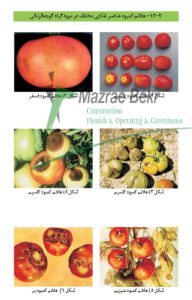
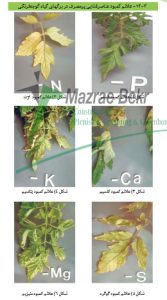
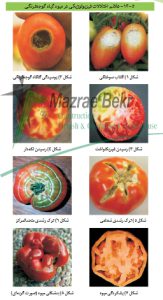
Greenhouse tomato harvesting
Greenhouse tomatoes are among the spices that can be cultivated for many reasons because this product is used in different foods and where it is not mainly available in the form of tomato paste makes the fooddelicious.
This is why there are varieties in tomato cultivation that are exactly in line with the conditions of tomato consumption. Fine tomatoes in sizes from 5 to 20 grams as well as tomatoes weighing up to 250 grams have been produced that due to the use of new techniques in addition to high resistance to many viruses and diseases, has the talent of durability and freshness for a long time.
The most important factor in tomato harvesting is when the tomato is ripe. If the contents around the seed are jelly so that with the sharp edge of the knife we can separate it from the seed, then the fruit of the tomato isripe.
If the fruit is painted red or pink but the fruit is stiff, the ripe fruit is stiff. Also, if the fruit is completely colored and soft, they say the fruit is ripe. For fresh consumption of tomatoes and its supply in local markets, it must be harvested when the ripe fruit is stiff. In order to supply the fruit to a little distant markets, they harvest the fruits when the green isripe.
If the fruit is fully grown and at the junction of the stem after the removal of the flower bowl a brown ring has been created say the fruit has beenpainted.
From the time of transplantation and its transfer to the main land, it takes 50 to 60 days to produce fruit, depending on plant nutrition, environmental conditions, plant pruning and planting season, which takes about 60 days in winter and about 50 daysin summer.
The fruiting period will be 2 to 3 months and in better conditions will be 4 months and fruit harvesting in spring is twice and in summer 3 times a week, which gradual harvest leads to increased yield and weight gain of premature fruits on the cluster.
Imridedfruit:
At this stage, the fruit is completely green, the seeds are grown and the jelly materials are not yet formed around the seed or are very stiff and cannot beseparated.
Ripe greenfruit:
At this stage, the fruit is fully grown and the jelly layers can be separated. The tissues inside begin to turn yellow or red. A brown ring of the stem junction is created after the removal of the flower bowl is suitable for when the product is sent to distantcities.
Coloredfruit:
In this stage, a quarter of the surface of tomato peel in the flower begins to be colored (yellowing andred).
RipeStiff:
The fruit color is completely pink or red, but the meat of the fruit becomes completely stiff and will not be damaged by mechanical pressures. This mode will be suitable for fresh harvesting and supply in localmarkets.
Fullhandling:
The fruit is completely red and softened and not marketable and the drop in quality and pricefollows.
The best way to harvest ripe tomato fruit is stiff and as a general rule the fruits they grow to send to remote areas should be smooth, meaty, medium size, suitable color and stiffness enough to not be damaged intransportation.
In cluster or cluster cultivars that 50% of the fruit is painted on the cluster and 50% is still green, they can be harvested and marketed to try not to wound tomatoes at harvest time because the wounds are created increase the amount of breathing and production of ethylene and the juice decreases.
It is better to harvest the first fruit in the morning when it is cold and the fruit temperature is not high, because the coolness of the fruits extends their lifespan. If we want to keep tomatoes, the temperature is 13 to 20 degrees for ripe green tomatoes and 7 to 10 degrees for ripe fruit is considered stiff.
In order to give natural color to tomatoes that have been harvested before full ripening, we can use heat from 21 to 24 degrees for 3 days or ethylene in proportion to 1 or 2 per thousand.
Wood and plastic boxes are used for tomato packaging and the best time to sell tomato product is winter to early spring. At the end of the growing season for final operations, operations are performed as stated in cucumbercultivation.
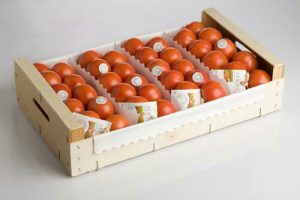
Export greenhouse tomatoes
One of the
major problems of exporting greenhouse tomato products, which has caused Iran to fail to find its place among other competing countries in the global competitionas itshould.The cost of theproduct compared to the competitors outside
– inappropriate distribution ofconversion industries according to the center and pole of agriculture,
– considerable exhaustion in the machinery sector of the production units
– Weakness inpackaging
– Exporters unfamiliar with export markets
Other keywords: tomato greenhouse, greenhouse, greenhouse, greenhouse, suitable greenhouse, tomato greenhouse, greenhouse suitable for tomatoes, greenhouse tomatoes in Mashhad, greenhouse tomatoes in Khorasan, tomato greenhouse in Mashhad, greenhouse builder of Mashhad, greenhouse builder of Khorasan, greenhouse builder of Khorasan, greenhouse of tomatoes in Iran, construction of tomato greenhouse, tomato greenhouse company, tomato greenhouse manufacturer, greenhouse construction Modern, best greenhouse tomato cultivation, greenhouse tomato cultivation training, greenhouse tomato seed, greenhouse tomato facility, greenhouse, standard greenhouse greenhouse, how to cultivate fish, comprehensive information about greenhouse tomato cultivation, all about greenhouse tomatoes, greenhouse cultivation of tomatoes, suitable structure of tomatoes, greenhouse cultivation of tomatoes.






